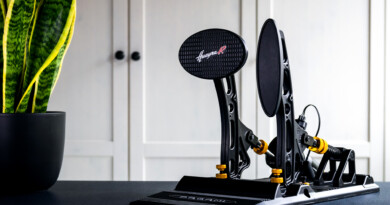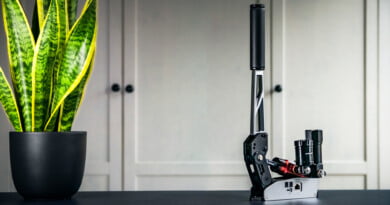Cammus LC100 Pedals
Shenzhen CAMMUS Electronic Technology Co., Ltd, better known as CAMMUS, is a tech company that entered the sim racing market in 2021. Despite its recent venture into sim racing, CAMMUS has been active since 2008 in the automotive industry, manufacturing car parts and even developing a fully electric Go-Kart and an electric supercar. During the global COVID pandemic, CAMMUS shifted its focus to the virtual car world, specifically in sim racing. Since 2021, they have built an extensive catalog of various sim racing hardware. Cammus offers steering wheels, wheelbases, and pedal sets designed exclusively for PC use. Having previously reviewed the CAMMUS GT1 DD Bundle, we were approached this time to test the load cell pedal set. Naturally, when asked if we wanted to write a review about the CAMMUS LC100 pedals, our response was a resounding “Yes.”
The CAMMUS LC100 pedal set, which we are about to review, is available in their official webshop for $399.00. At the time of writing, CAMMUS is offering a temporary 35% discount, reducing the price to $259.00. If you use the discount code “srbcammus,” you can enjoy an additional 5% off.

Packaging & Contents
Our package containing the LC100 pedals, which is quite hefty, was delivered to our door in less than a week via UPS. Upon removing two standard boxes, the actual product box is revealed. The product box is a sleek, square box with a glossy black base color. Both the front and back feature a prominent image of the pedal set, with “LC100” subtly printed behind the pedals and a clearer “pedals” below the pedals. Under the baseplate, there’s a slightly faded reflection of the product that initially seemed like a smudge on the box. The front of the box is neatly finished with the “CAMMUS” text in the bottom right corner. A detail we appreciate about this box is the plastic handle on the top, making it easy to lift despite its weight. Overall, it’s a well-presented box that excites us to delve in and start using the pedals right away.


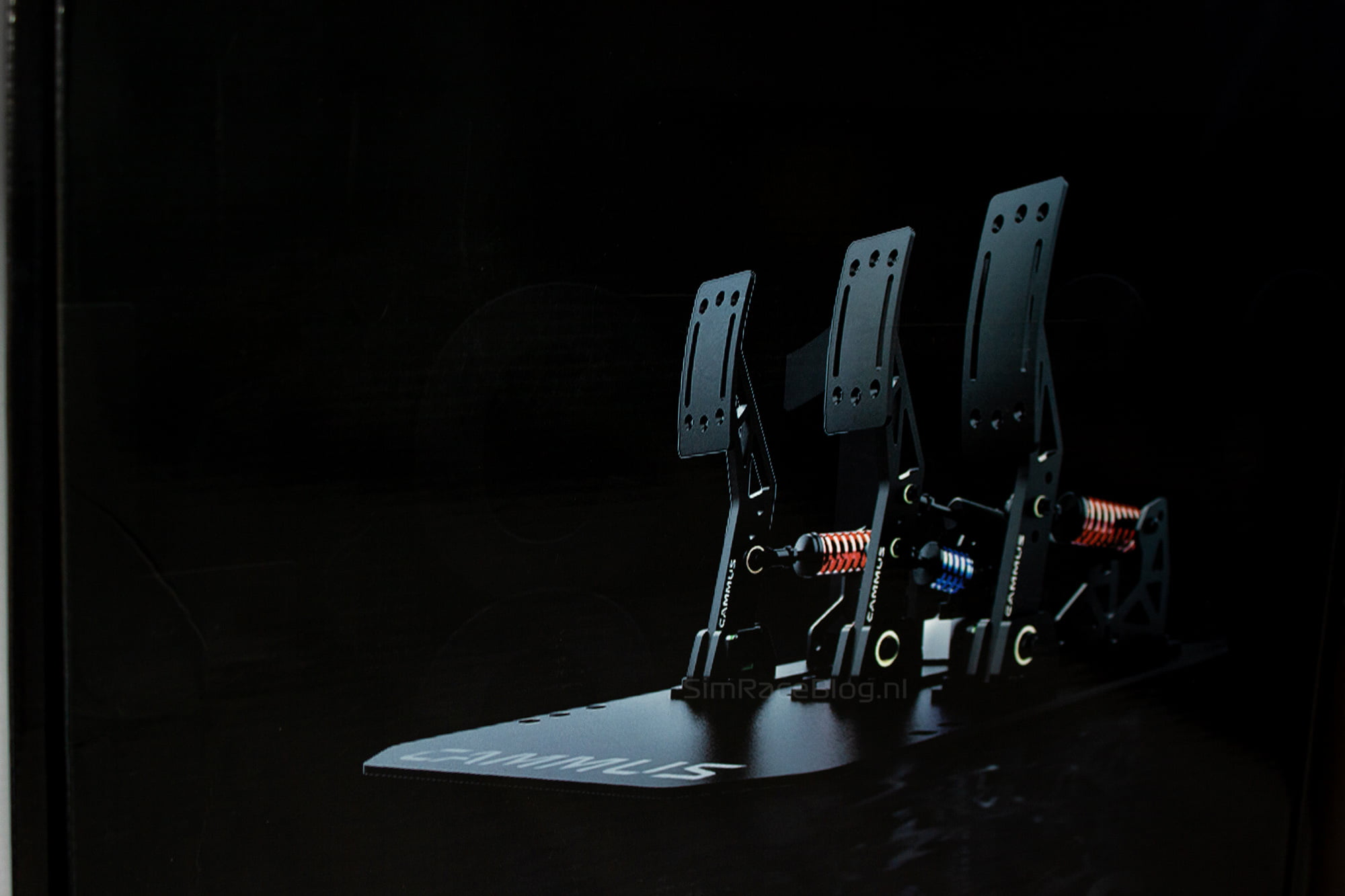
Opening the box immediately lifts our spirits. The front of the box serves as the lid, allowing us to unfold it like a pizza box and access the contents right away. The first thing we encounter is a tidy black foam sheet with the LC100 pedal manual neatly placed on top. After removing the foam sheet, we reveal the box’s contents. Inside, there’s a sturdy block, also made of black foam, housing the three pedals snugly for protection. In addition to the three pedal slots, there’s a fourth rectangular opening containing the controller, a bag of screws and tools, a cable with an RJ45 connector for potential connection to a CAMMUS wheelbase, and a USB cable for direct PC connection. Finally, removing this foam layer from the box, we find at the very bottom, also nestled in foam, the rather sizable baseplate for the pedals


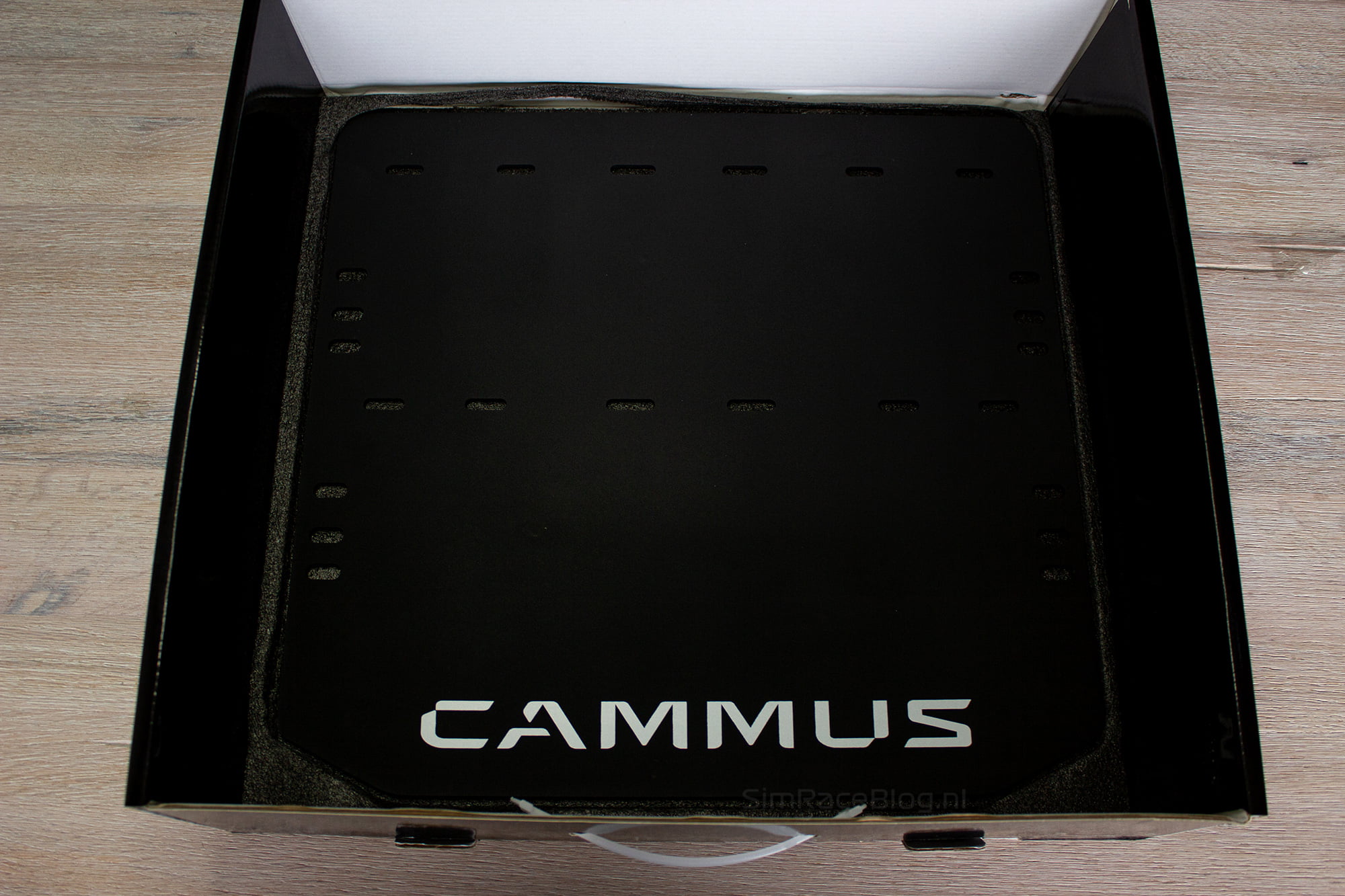


Technology & Quality
The reason the box for this pedal set felt so substantial is that the pedals are fundamentally constructed from steel components. Each of the three pedals features a base made of 4mm thick sheet steel, with the pedal arm attached to two protruding cams, each made of 8mm thick steel. The entire assembly is coated with a matte black finish that feels pleasantly textured to the touch. However, the mentioned arm of each pedal is crafted from a beautifully machined aluminum part, subsequently coated with a glossy black anodized layer adorned with CAMMUS branding on one side. To complete the pedals, they all have a steel footrest with the same finish as the base of the pedals. All three pedals are positioned at nearly a 90° angle to the baseplate, giving the pedal set the appearance of pedals from a formula car. Naturally, each pedal has its own unique features.
The accelerator pedal
The accelerator pedal in the LC100 pedal set is easily recognizable by its light blue spring. Due to the central axis of the pedal being attached to the side of the pedal arm, the accelerator pedal itself has a slight offset to the right from the center of its base. The light blue spring around the central axis provides resistance to give the pedal a tactile feel. The preload of this spring can be adjusted using a ring mounted on the central axis, compressing the spring for a firmer pedal feel with a clockwise turn. If this doesn’t achieve the desired result, the aluminum arm of the pedal has three holes at different heights where the central axis can be attached. Adjusting the height of this attachment point alters the angle at which the force of the spring acts on the pedal, creating a different pedal feel. To regulate the pedal’s travel, CAMMUS employs a system where hard plastic bushings are slid onto the central axis to act as end stops. If you wish to increase or decrease the pedal travel, you can remove the pedal axis and add or remove plastic bushings accordingly for the desired result. Beyond adjusting preload and travel, no other modifications can be made to this pedal, meaning the pedal’s angle and the height of the footplate remain fixed
To transmit the pedal position of the accelerator pedal to the PC, a Hall sensor is employed. This system utilizes a magnet moving along the sensor, allowing for a reliable and frictionless determination of the pedal’s position. The position information is then sent to the controller via a thin cable, which, in turn, relays the signal to the PC. An advantage of this cable is that it is clicked into the base of the pedal, making it easily replaceable in case of any malfunction.




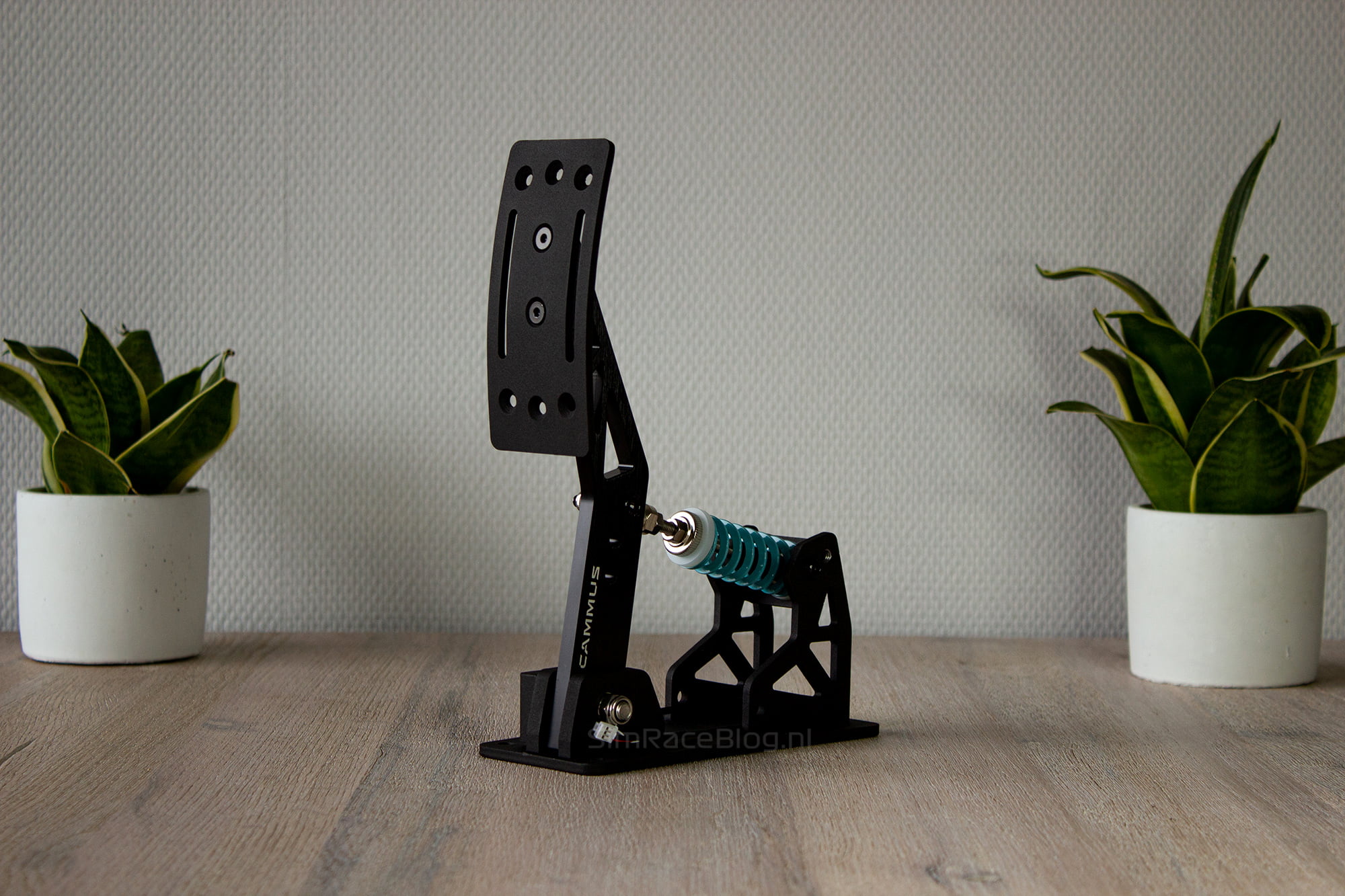

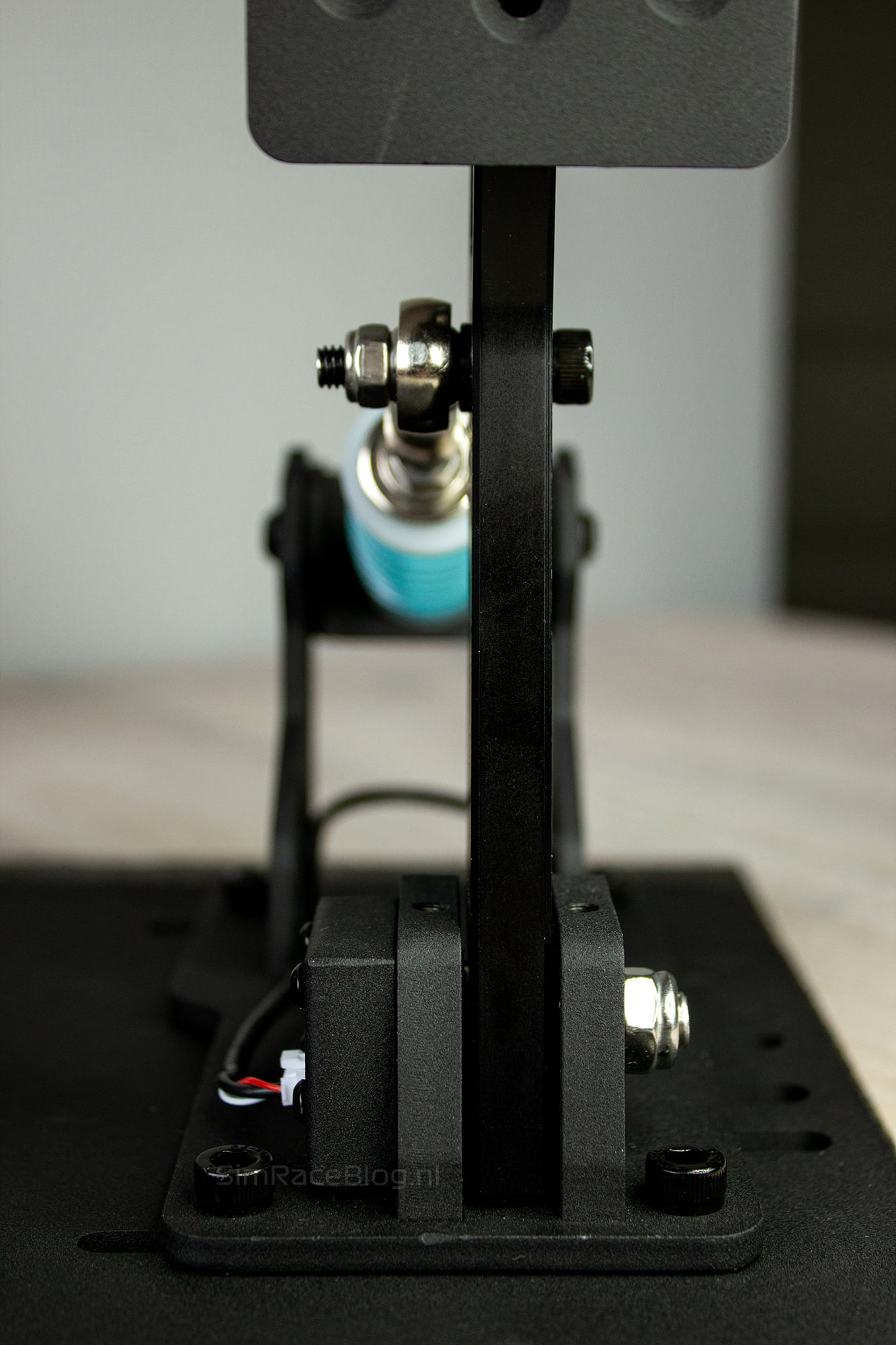

The brake pedal
For the brake pedal, CAMMUS has implemented a unique system. The brake pedal features two axes. The first axis is a familiar sight in pedals equipped with a load cell, comprising both a spring and an elastomer. In this configuration, the spring mainly provides preload and contributes to the feel of the brake, while the elastomer is responsible for the actual stiffness of the brake pedal. The second axis on the brake pedal of the LC100 pedal set is a bit more distinctive, being connected to a damper. The concept behind this damper is that the pedal feel can be adjusted literally at the turn of a knob. On the back of the damper is a rotary knob with 8 positions, where position 1 is the lightest and position 8 makes the brake pedal very stiff. In theory, this is an intriguing concept that we are eager to test. It means we can quickly adjust our pedal from a street car feel to a formula car feel within a matter of seconds. The travel of the brake pedal can be adjusted in a slightly different way compared to the other pedals. In this case, the adjustment is made by moving the damper. The damper is held in place by two large nuts on either side of the rear bracket of the pedal. By turning these nuts, the damper can be shifted slightly closer or further away from the end of the connected axis. This makes the housing of the damper act simultaneously as a hard end stop for the pedal.
As mentioned earlier, the brake pedal of this pedal set is equipped with a load cell. This load cell can transmit the signal to the connected computer under a load of up to 100kg, indicating its robust capability. Like the accelerator pedal, the brake pedal is connected to the controller before relaying the signal to the computer. In contrast to the accelerator pedal, the brake pedal has a fixed cable attached to the load cell.







The clutch pedal
The last pedal of the LC100 pedal set, dedicated to the clutch, bears many similarities to the accelerator pedal. Nevertheless, there are a few subtle differences to distinguish these pedals from each other. The first distinctive feature is the clutch pedal’s spring, which has an orange color compared to the blue spring found on the accelerator pedal. This spring is mounted at a slightly different angle, altering the pedal feel compared to the accelerator pedal. The clutch pedal also shares the same footrest as the brake pedal, which has a footrest smaller than the one mounted on the accelerator pedal. Lastly, the clutch pedal, like the accelerator pedal, has a small offset from the center of its base. However, for this pedal, the offset is to the left instead of the right






The baseplate
The 3mm thick baseplate of the CAMMUS LC100 pedal set is quite big in size, measuring 400mm in depth and 420mm in width. This flat steel plate shares the same matte black finish as the pedals, featuring a similarly lightly textured surface. On the front of the baseplate, you’ll find the CAMMUS logo in large white letters. In the center of the plate, there are 12 slot holes, each approximately 20mm in length, for mounting the pedals. Each pedal utilizes 4 slots for secure attachment. Along the left and right edges of the baseplate, there are an additional 12 slot holes, this time with slightly shorter lengths. These slots, divided in two groups of three on each side, can be used to attach the baseplate to a pedal deck.

The controller
The controller of the LC100 pedals features a sleek black aluminum housing adorned with the CAMMUS logo on top. On the left side of the housing, you’ll find two outputs, one consisting of a USB-B port and the second being an RJ-45 UTP port. Adjacent to these two ports, there is a small hole housing the reset button. On the right side of the controller, you’ll find the inputs for the pedal connectors, with a 3-pin connection for the accelerator and clutch pedals, and a 4-pin connection for the brake pedal.



Mounting
Before mounting the pedal set on our rig, we first attach the individual pedals to the provided baseplate. As previously mentioned, there are four horizontal slots, approximately 20mm in length, milled into the baseplate for each pedal. This design allows the pedals some flexibility in adjusting their distance from each other. On the pedals themselves, there are two holes drilled on each side, through which the supplied screws can easily be inserted and then secured from the bottom with a lock nut. One thing we feel is missing is a couple of washers that could be placed under the lock nut. Currently, the lock nut has to clamp onto a slot, which, for us, feels a bit less secure, even though the nut naturally has a larger radius than the slot. Nevertheless, the assembly is straightforward with the provided materials and tools.
After securely attaching the pedals to the baseplate, our attention turns to finding a place for the controller. However, it turns out that the baseplate lacks any mounting holes for a controller or a holder. Upon closer inspection of the provided components, we realize that the LC100 pedals do not come with any mounting bracket or screws. In fact, the controller itself only has holes for cables, not for potential screws to secure it in place. We find this somewhat inconvenient. Every sim racer likes to keep their rig neat, and a loose or hanging pedal controller doesn’t contribute to that tidy appearance. Mounting a controller requires only a simple bracket with a few small screws. In our opinion, CAMMUS should have included this with the pedal set, especially considering these pedals are intended for more serious sim racing setups.



As the CAMMUS LC100 pedals stand upright, we decide that these pedals will likely be best suited for our FormulaSimRigs Avanzata, which emulates the seating position of a formula car. Attaching them to the aluminum profiles of our rig is a straightforward task that doesn’t take much time. Due to the considerable weight of the pedal set, we need to be cautious with our fingers during alignment on our pedal deck. Once in place, we can begin securing them. Unfortunately, the supplied materials are not sufficient for mounting on aluminum profiles and are more suited for attachment to a pre-drilled pedal deck. Notably, no T-slot nuts are included, and the standard bolts are too long to be used with our own nuts. Fortunately, we have a small supply of fasteners for such situations, allowing us to effortlessly secure the LC100 pedal set in place on our rig.


Software
Before we can dive into using the pedals, we need to download and install the CAMMUS software. We head to the Downloads page on the CAMMUS website and retrieve the software, which interestingly doesn’t have a specific name. After downloading, we proceed to install it immediately. Upon opening the software, we encounter a clean main screen with several menus on the left and the CAMMUS Supercar in the background. In the main menu, it becomes apparent that our PC has already recognized the pedals, as there is an image of the LC100 pedals with a large green button above them in the Active Devices section. However, clicking this green button doesn’t yield any response.

When we navigate to the Devices menu, we are able to select the pedals. Immediately, an overview of the 3 input signals from the pedals appears on the screen. Checking the box for “Set Max&Min” brings up six green buttons, allowing us to calibrate the pedals. For each pedal, we can choose “set min” and “set max.” Without touching the pedals, we click “set min” for all 3 pedals. Then, one by one, we press each pedal and click on the “set max” button. Calibration doesn’t get much simpler than this.
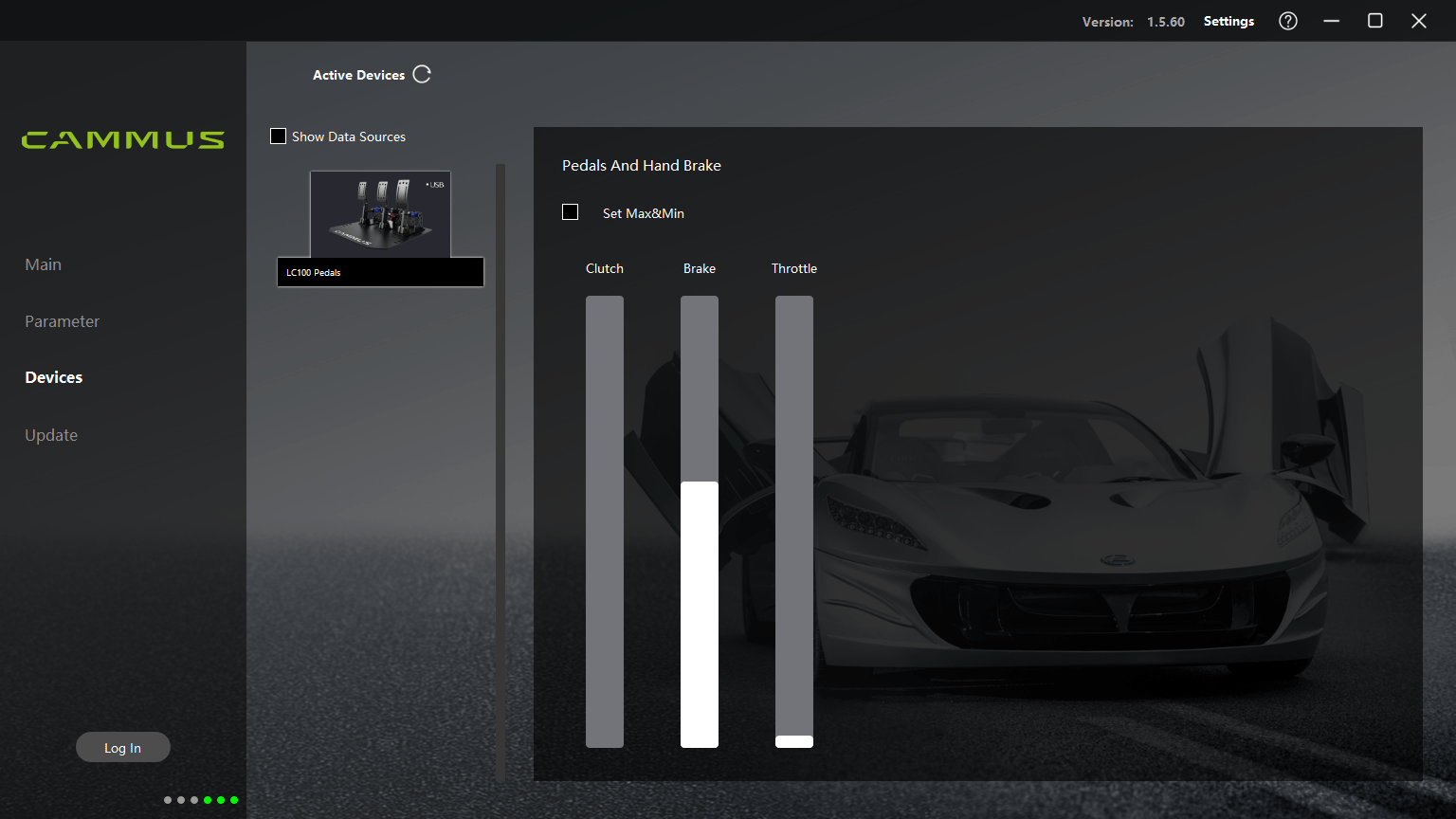

The software has two other tabs, namely “Parameter” and “Update.” The “Parameter” section doesn’t offer much for us as it is designed for CAMMUS wheelbases. However, the “Update” section is a handy addition. In this menu, we can directly view the software versions of both the steering software and the firmware for all CAMMUS equipment. Clicking on the “Open Firmware Update Assistant” button at the bottom takes us to a new menu where, with a simple click on an Update button, we can update our equipment to the latest firmware version. CAMMUS has ensured that, much like the calibration process, this is a straightforward procedure.


Using the CAMMUS LC100 pedals
With all firmware up to date and our pedals calibrated, we are ready to begin using the LC100 pedals. We launch Assetto Corsa to take our first laps in the Tatuus FA01.
The initial impression we get from the pedal set is somewhat mixed. Fundamentally, it seems like a decent set. Each pedal feels sturdy, and while driving, we sense virtually no play in the pedals. The footrests of the pedals have a shape that feels comfortable under our feet, even when driving in socks. The rough texture found on both the baseplate and the footrests provides a nice grip without hindering the smooth movement of the pedals under your feet. However, we do encounter some drawbacks as we delve into using the pedals.
The accelerator pedal
The accelerator pedal is pleasant to use. However, we quickly notice that it has a somewhat long stroke out of the box, requiring us to stretch our foot quite a bit to reach the end stop. To shorten the stroke, we can add black plastic bushings to the series of bushings already around the central axis of the pedal. While this may not seem like a problem, the LC100 pedals do not come with additional individual bushings. This means that we have to take bushings from the clutch pedal to adjust the accelerator pedal. We find it regrettable that we have to sacrifice the clutch pedal for a better feel in the accelerator pedal, especially considering that it would be relatively inexpensive to include a few extra plastic bushings with each set. After adding the extra bushings, the pedal travel feels good. However, we still prefer to increase the preload when reducing the travel to maintain some precision. Sadly, we encounter a bit of an unwanted side effect here as well. When we increase the preload, the pedal travel is automatically reduced. Unfortunately, these two parameters are linked, and the preload of the pedal cannot be adjusted without the travel also changing. After some trial and error, we find a pleasant balance between travel and preload that works well for us.
With the pedal adjusted to our liking, it becomes a very pleasant accelerator pedal. The pedal feels smooth, and the plastic bushings act as a solid end stop, providing a gentle damping effect without producing any unwanted noises. The resistance we feel from the spring is present in a pleasant manner, allowing for easy and precise control of the accelerator pedal.
The brake pedal
The brake pedal is by far the most remarkable pedal in the LC100 pedal set. With its dual-axis design to create pedal feel, we are incredibly curious about racing with this pedal. Initially, the brake pedal’s travel is a bit too long for us to comfortably drive. Unlike the accelerator pedal, the brake pedal uses the damper on the upper axis as an end stop, eliminating the need for additional plastic bushings. Shortening the pedal travel is easy by adjusting the two nuts that secure the damper, a modification that can be made within a minute. To enhance the Formula feel in our pedal set, we decide to set the pedal to a firm level. With the damper set to position 1, we can easily press the pedal by hand. By turning the back of the damper, we gradually increase it to position 8, which is also the hardest setting. This makes the pedal feel very firm, illustrating how the damper can drastically alter the pedal feel without requiring any tools.
It appears that there’s a significant issue with the brake pedal feel during calibration. When depressing the brake pedal for slightly longer than 1 second during calibration, the damper slowly allows the fluid to run again. While this behavior is normal for a damper, it introduces an undesirable sensation during braking. Initially, the brake pedal feels hard and solid, then it gradually sinks into a spongy feel. This means that during initial braking, the pedal is firm, then it softens, giving the impression of pressing on an ice cube that immediately melts after stepping on it. Unfortunately, this problem isn’t limited to the pedal feel; examining the brake signal in the software reveals that during initial braking, the brake pressure reaches about 75%, then slowly increases to 100% as the pedal softens. This issue can’t be calibrated away, making it nearly impossible to use the pedal at its hardest setting. Upon closer inspection, the cause becomes apparent. The upper axis, where the damper is attached, is connected to the pedal arm and the pedal housing. Simultaneously, the lower axis, which houses the spring and elastomer, is attached to the pedal arm and the load cell system on the other side. Consequently, the damper impedes the pedal while preventing the lower axis from exerting pressure on the load cell. As the damper releases fluid and softens the pedal, the lower axis is allowed to press on the load cell again. This design flaw severely limits the usability of the LC100 brake pedal at its hardest setting, with only positions 1 to 3 proving practical without negatively affecting the brake signal.
Knowing this, we set the damper to position 2 and try to maximize the preload on the load cell. With this configuration, the pedal becomes usable but doesn’t fully live up to its potential, where the pedal could be easily adjusted from soft to hard and everything in between. In this setup, with the damper on position 2, the brake pedal functions as a soft brake pedal where the feel is entirely determined by the spring and elastomer on the lower axis. However, these components themselves don’t provide a precise and satisfying feel. On its lightest settings, the pedal feels relatively numb and linear, making it almost resemble a brake pedal with a torsion spring and a Hall sensor.
The clutch pedal
The last pedal of the LC100 pedal set, the clutch, is, like the gas pedal, a decent pedal. However, out of the box, the pedal feels linear, and there is no simulated engagement point of the clutch perceptible. In this regard, we must be honest; this is not really a drawback for a pedal set in this price range, and we don’t expect it.
After removing the plastic bushings from the clutch pedal to place them in the gas pedal, the pedal’s travel has significantly increased. A positive side effect that has emerged is that the pedal seems to simulate a bite point with a longer travel. However, this would only be noticeable when the pedal is positioned in a GT seating posture, as it is too long to fully depress in a formula seating position.

Conclusion
After spending several hours with the CAMMUS LC100 pedal set, we have mixed feelings about it. Fundamentally, it is a decent pedal set. Everything feels sturdy, and the matte black finish gives it a neat appearance. Therefore, it’s a bit disappointing that the controller of this pedal set cannot be neatly concealed or secured, detracting from its sleek look.
Our feelings about the pedals themselves are also quite mixed. The throttle pedal satisfies us in terms of feel; it’s a nice pedal when properly adjusted. Shortening the pedal stroke with the black bushings works well, and these bushings serve as a proper end stop. However, it’s unfortunate that no extra bushings were included, requiring us to take them from the clutch pedal. Adjusting the preload always involves a change in the pedal stroke, which can be challenging at times. Once the balance is found, it’s a pleasant pedal. The major drawback of this pedal set lies mainly in the brake pedal. The brake pedal uses a separate axis with an adjustable damper. This damper works extremely well to alter the pedal feel. However, the damper prevents the load cell from being used effectively, making the brake signal unusable with a damper setting above 3. Consequently, the pedal can only be used as a light brake pedal, which unfortunately feels relatively linear, similar to a pedal with a torsion spring and Hall sensor. We sincerely hope that CAMMUS can find a solution for this in the future because the dual system on the brake could be an excellent solution for quickly adjusting your pedal. Regarding the clutch pedal, we can be brief; like the throttle pedal, it is a decent pedal. However, removing plastic bushings from the pedal, to shorten the throttle pedal’s stroke, may result in the clutch pedal having a longer stroke than desired.
However, bottom line, we believe that there is potential in CAMMUS’s LC100 pedals. When the throttle pedal is properly adjusted, it’s enjoyable to drive with. By adding extra plastic bushings, all pedals could remain usable for a complete feel. However, it’s primarily the brake pedal that needs a bit more attention. If further developed, we believe that the CAMMUS LC100 pedal set could become an intriguing choice for sim racers looking to upgrade to a load cell pedal set without spending too much money.
The CAMMUS LC100 pedal set, in our opinion, is quite pricey at $399.00, excluding shipping, considering what you currently get in return. At the time of writing, the pedal set is available in their official webshop with a 35% discount, bringing the price down to $259.00, excluding shipping, which we find to be a more reasonable price for this pedal set. If the discount code “srbcammus” is applied during checkout, an additional 5% discount is applied.
Do you want to stay informed about SimRaceBlog content, news, announcements and (future) give-aways? Follow us on Instagram @simraceblognl and/or our Discord channel.











